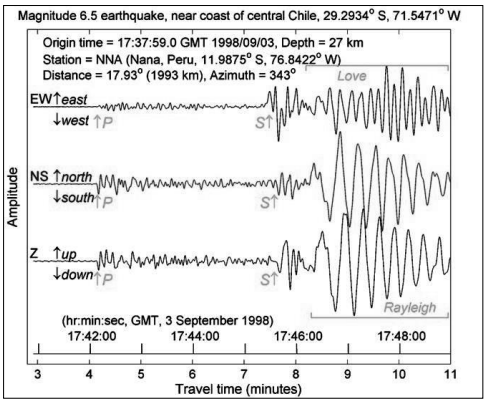Questões de Concurso Para cemig - mg
Foram encontradas 1.433 questões
Resolva questões gratuitamente!
Junte-se a mais de 4 milhões de concurseiros!


I. O movimento livre do terreno num ponto qualquer é o resultado da propagação de ondas de corpo sólido ou esféricas, classificadas em longitudinais, transversais e de superfície, e de reflexões e refrações em subsuperfície.
II. O registro de um evento sísmico é particular a cada estação de monitoramento apenas em decorrência da heterogeneidade do meio de propagação das ondas sísmicas - ou seja, a constituição do subsolo entre o hipocentro e cada estação é única.
III. A resposta de qualquer estrutura, natural ou artificial, a um evento sísmico depende da relação, expressa na forma de magnitude do evento sísmico, entre a frequência natural de vibração dessa estrutura e a frequência de vibração do terreno.
Em relação aos pressupostos da sismologia geral,
O conceito de magnitude foi desenvolvido por C. Richter (1935, inspirado em observações de K. Wadati publicadas em 1931), que chegou à expressão
M = log(A/T) + f(Δ, h) + Cs + Cr
sendo
A = amplitude máxima (μm), T = período das ondas sísmicas (s), f = fator de correção para a distância epicentral Δ e para a profundidade focal h, Cs = fator de correção para a estação sismológica e Cr = fator de correção regional.
Fonte: T. K. Datta. Seismic analysis of structures. Singapore: John Wiley & Sons Asia, 2010, p. 13-41.
Avalie as seguintes afirmações feitas acerca de parâmetros descritivos de sismos.
I. Uma escala logarítmica de intensidade de sismos, como MS e Mw, admite valores negativos para sismos de muito baixa energia.
II. Há diversas escalas de magnitude, pois as ondas sísmicas se propagam de diversas maneiras a partir de uma mesma fonte.
III. Há diversas escalas de intensidade, especialmente úteis em áreas nas quais não há instrumentos capazes de registrar diretamente os eventos sísmicos de maior energia.
IV. Por tratar apenas dos efeitos dos sismos sobre estruturas locais, a medida de intensidades é menos importante que a medida de magnitudes, que explica as causas dos sismos.
Está CORRETO o que se afirma em: